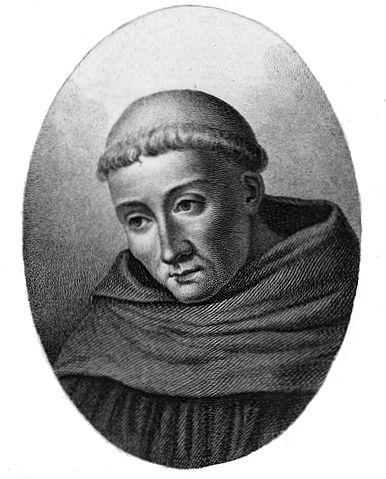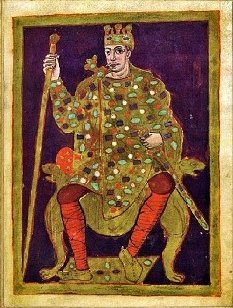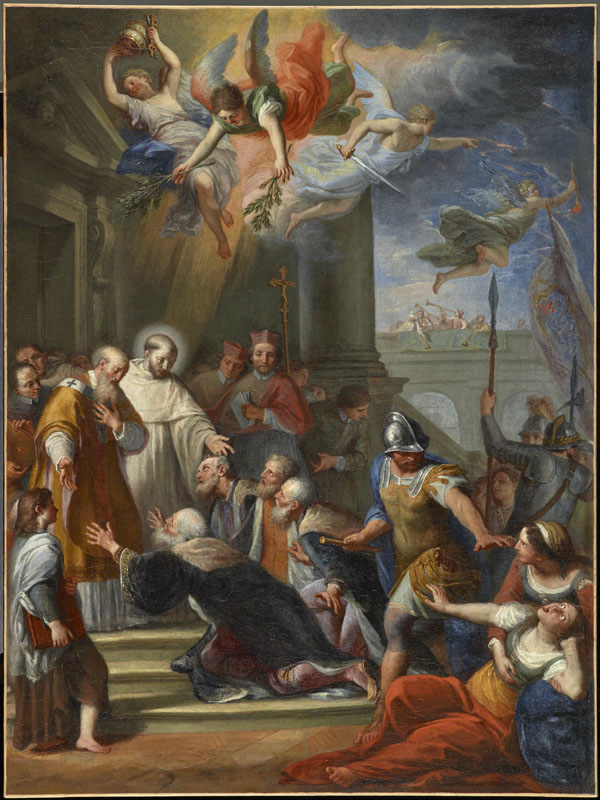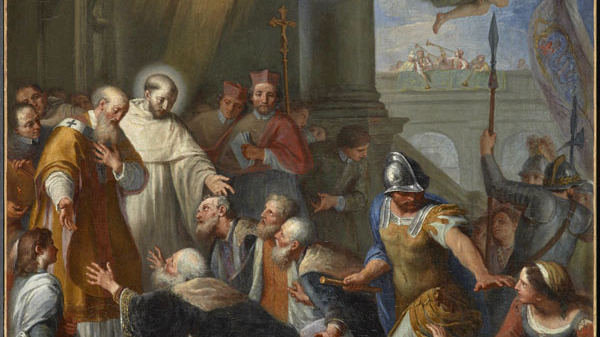This is a Reprint from Feb. 2, 2020. To read this Article in FRENCH click the image above.
THE FEAST OF ST. BERNARD IS AUGUST 20TH.
by Br. Alexis Bugnolo

As I mentioned at the beginning of my recent article on Saint Vincent Ferrer, there have been many antipopes and schisms in the Church before, when there were more than one pope and parts of the Church sided with one or another of the claimants. And in some of these crises, God sent Saints to give us an example in the future of how it will please Him that we also should act in similar circumstances.
These examples of the Saints are of great value today, seeing that the Church again has 2 popes: Pope Benedict XVI and Pope Francis. By divine faith we know there only can be one pope at any one time, and thus there is rightly in the Church a disagreement about who is the true pope and who should not be claiming the dignity of pope at all or any more.
Saint Bernard of Clairvaux, on the question of discerning who is the true pope had a lot more sense and grace than Saint Vincent, if we can compare Saints at all. But Saint Bernard had an easier case to judge, since he did NOT rely on the personal testimony of a friend who was a Cardinal, involved in a disputed election.
The Schism of Anacletus II
The crisis in Saint Bernard’s day arose with the death of Pope Honorius II on February 13, 1130 A.D.. Before his death, the Pope had issued a special decree, whereby his successor would be elected by a commission of 8 Cardinals, appointed therein, instead of by all the Cardinals. After his death, though his corpse was not yet even buried, the Dean of this commission, Haimeric of Chartes, the papal chancellor and Cardinal Deacon of Santa Maria della Scala, on the morning of the 14th, convened the Cardinals favorable to the faction of the noble family of the Frangipani, at Saint John Lateran’s — where the mortal remains of Pope Honorius had been moved — and they elected Giovanni Papereschi dei Guidoni, as Pope Innocent II. He was consecrated Bishop the same day.
The other cardinals, led by Pietro Pierleoni, of the rival Roman noble family — one descended from converted Jews, but which conducted a lot of business with them still — convened the uninvited Cardinals to the Basilica of San Marco (today on the Piazza Venezia) where once elected, he took the name of Pope Anacletus II.
The Frangipani and the Pierleoni had been rivals for the papacy for decades, so the controversy was not new and the passions among them not quelled. But the legal case was a simple one: the pope elected according to the Papal laws existing at the time of the death of the pope, is the only one with the legitimate claim. If the special law of Pope Honorius II had not existed, both elections would probably have been invalid, on account of the failure to invite all the Cardinal Electors to the same meeting.
 Pope Innocent, not being a Frangepane, soon lost several Cardinal supporters who had voted for him, and fled from Rome, his position there being untenable politically. So he and his followers boarded 2 galleys at Ostia and set sail for Pisa, where he remained in exile for nearly all of 1130. Then he sailed to Genoa and onward to Provence, where he sought refuge with the famous Abbot Suiger of Saint Denis, his friend and ally at Paris.
Pope Innocent, not being a Frangepane, soon lost several Cardinal supporters who had voted for him, and fled from Rome, his position there being untenable politically. So he and his followers boarded 2 galleys at Ostia and set sail for Pisa, where he remained in exile for nearly all of 1130. Then he sailed to Genoa and onward to Provence, where he sought refuge with the famous Abbot Suiger of Saint Denis, his friend and ally at Paris.
At the request of Suiger, the King of France, Louis VI, called a Council at Etampes, to determine who had the rightful claim to the Papal Throne — notice how the King had no scruples to call an imperfect council to obtain a legal determination in the controversy — And all the Bishops of France in attendance, having seen the comportment of Saint Bernard of Clairvaux in the previous Council of Troyes in 1128, elected the Saint to be the sole arbiter of which claim was the legitimate one.
And Saint Bernard chose Innocent II, because only he had been elected according to the special law of Pope Honorius II.
The 9 yr Mission of St. Bernard for the true Pope
Here began the great work of Saint Bernard for Holy Mother Church. For it was not enough for him to have judged who was the true Pope, he set out to be the Warrior par-excellence for the cause of the true pope, Innocent II. First they went to Clermont, where another Synod was convened and Innocent was recognized as the true Pope.

With support of the leading ecclesiastics of Germany, Bernard persuaded the German princes to declare for Innocent at the Council of Worms in the same year. Then he met Lothair of Supplinburg, and accompanied the true Pope to Liege in Burgundy, where from his hands Lothair received the Crown of the Germans on March 22, 1131 and took the regnal name of Lothair III.
He then accompanied the Pope to Paris and Clairvaux and onward to Rheims, were another Council was held, on October 18, 1131, proclaiming Pope Innocent the true Successor of Saint Peter. Following the Council, Pope Innocent II crowed Louis VII, King of France. The representatives of the courts of the Kings of England, Aragon and Castile, who also pledged for Innocent.
Bernard then went to the Duchy of Aquitaine, where he convinced the Count of Poitiers to abandon his support of Anacletus II.
In 1132, with the support of Lothair and his small army composed primarily of imperial cavalry, Pope Innocent descended into Italy with Saint Bernard to capture Rome back to the Church. Having succeeded to enter the city, Pope Innocent crowned Lothair Emperor of the Romans on June 4, 1133. But with the Emperor’s return to Germany, the Pope found the Romans hostile and increasing loyal to the antipope, Anacletus II, who had shut himself up in the fortress of Castle San Angelo, near the Vatican. So Innocent withdrew with all his retinue, Saint Bernard included.

Saint Bernard, never to give up, accompanied the Pope to Pisa, where a great Council was called, and the representatives of Spain, England, France, Germany, Hungry and the most powerful lords of Italy attended. They declared for Pope Innocent II. This left only the Kingdom of the Two Sicilies and Rome itself in the allegiance of the antipope.
The conflict went on for another 5 years, and the antipope, Anacletus II did not live to see it ended: he died in schism from the true pope on January 25, 1138. His Cardinals elected other antipope to succeed him, Victor IV. And seizing the opportunity for negotiation, Saint Bernard spoke with him and convinced him to surrender to Pope Innocent II and renounce all claims to the papacy.
The Schism was officially declared ended in 1139, when Pope Innocent II convened the Second Lateran Council and explained to the entire Church the legal facts of the case. Anacletus was declared an antipope, and his memory has lived ever on in infamy.
Reflection on the Lessons St. Bernard gives us
Saint Bernard was not a “recognize and resist” do nothing. He was not interested more in the money he could make at his Monastery by being friends with the antipope, than his duty before God to support the true Pope. Nor was he one of those who said, “there is no mechanism in the Church” to judge an antipope. And he certainly was not one to say of someone with a doubtful claim, that those who oppose such a claim are “extremists”. Nor was he one of those fakers, who claims that a Schism of the Church must only be settled by the clergy, and not by political intervention of the sovereign powers.
He not only was in favor of imperfect Synods, as we call them today, he convened them. He was not only in favor of armed military solution, but he led them into battle! He was not oblivious to canonical facts, he accepted them and preached them. He was so unlike nearly everyone in the Sacred Hierarchy today, that he is an example and role model to be imitated by all, Cardinals, Bishops, Priests, Monks and Laymen.
So when next you hear someone say, there is nothing that we can do to rid the Church of an Antipope or heretic, or restore a true Pope to power, remember the example of Saint Bernard of Clairvaux and his 9 year long war against Anacletus II. Because Saint Bernard, a most devout son of the Blessed Virgin, a most zealous disciple of Jesus Christ, patron of the Templars and zealous suporter of the Second Crusade, did it all!
_________
CREDITS: The image of Pope Innocent II is taken from This illustration is from The Lives and Times of the Popes by Chevalier Artaud de Montor, New York: The Catholic Publication Society of America, 1911. It was originally published in 1842. The illustration is based on Pontificum Romanorum effigies by Dominicus Basa, Giovanni Battista Cavalieri (1580). — The image of Victor IV’s submission is from the Collection of the Museum of Fine Arts, Dijon, by Antonio Pietro dei Pietri.
+ + +



Correct the credit: Victor IV, not Ii.
Thank you for catching that.
Pas de quoi.